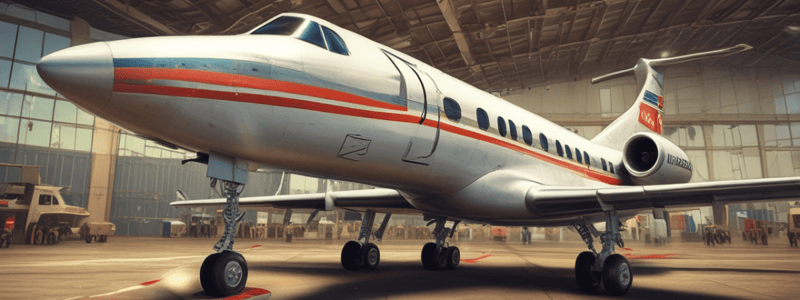Podcast
Questions and Answers
What is the primary objective of applying a risk management approach to maintenance activities?
What is the primary objective of applying a risk management approach to maintenance activities?
- To meet the minimum regulatory requirements
- To improve the efficiency of maintenance tasks
- To reduce costs associated with maintenance errors
- To identify potential hazards and implement mitigating actions to reduce risks (correct)
What is the key factor to consider when selecting vendors and suppliers for outsourcing maintenance tasks?
What is the key factor to consider when selecting vendors and suppliers for outsourcing maintenance tasks?
- Their pricing and cost-effectiveness
- Their location and proximity to the maintenance facility
- Their high-quality standards and proven track record of regulatory compliance (correct)
- Their experience with similar aircraft models
What is the primary purpose of regularly reviewing maintenance documentation?
What is the primary purpose of regularly reviewing maintenance documentation?
- To ensure compliance with FAA regulations
- To update the maintenance program as aircraft configurations or operational roles change (correct)
- To identify areas for cost reduction
- To improve the efficiency of maintenance tasks
What is a key characteristic of a robust maintenance strategy?
What is a key characteristic of a robust maintenance strategy?
What is the consequence of not implementing a robust maintenance strategy?
What is the consequence of not implementing a robust maintenance strategy?
What is the primary benefit of following a robust maintenance strategy?
What is the primary benefit of following a robust maintenance strategy?
What is the importance of updating the maintenance program as aircraft configurations or operational roles change?
What is the importance of updating the maintenance program as aircraft configurations or operational roles change?
What is the role of regulatory compliance in maintenance?
What is the role of regulatory compliance in maintenance?
What is the consequence of not reviewing maintenance documentation regularly?
What is the consequence of not reviewing maintenance documentation regularly?
What is the importance of attention to detail in maintenance?
What is the importance of attention to detail in maintenance?
Risk management approach is only applicable to maintenance tasks outsourced to vendors.
Risk management approach is only applicable to maintenance tasks outsourced to vendors.
Vendor and supplier selection is only based on cost-effectiveness.
Vendor and supplier selection is only based on cost-effectiveness.
Maintenance documentation review is a one-time process.
Maintenance documentation review is a one-time process.
A robust maintenance strategy can be developed once and never need updating.
A robust maintenance strategy can be developed once and never need updating.
Regulatory compliance is not a critical aspect of maintenance.
Regulatory compliance is not a critical aspect of maintenance.
Maintenance errors or oversights can be completely eliminated.
Maintenance errors or oversights can be completely eliminated.
Airworthiness standards are only applicable to new aircraft.
Airworthiness standards are only applicable to new aircraft.
Only certain types of aircraft require a robust maintenance strategy.
Only certain types of aircraft require a robust maintenance strategy.
A robust maintenance strategy is only necessary for commercial aircraft.
A robust maintenance strategy is only necessary for commercial aircraft.
Attention to detail is not critical in maintenance activities.
Attention to detail is not critical in maintenance activities.
What is the significance of consulting manufacturer's recommendations in developing a maintenance plan?
What is the significance of consulting manufacturer's recommendations in developing a maintenance plan?
What is the purpose of creating a detailed inspection schedule in a maintenance plan?
What is the purpose of creating a detailed inspection schedule in a maintenance plan?
Why is it essential to plan for unscheduled maintenance in a maintenance plan?
Why is it essential to plan for unscheduled maintenance in a maintenance plan?
What is the importance of implementing a record-keeping system in a maintenance plan?
What is the importance of implementing a record-keeping system in a maintenance plan?
Why is continual training essential for maintenance staff?
Why is continual training essential for maintenance staff?
What is the purpose of proactive compliance monitoring in a maintenance plan?
What is the purpose of proactive compliance monitoring in a maintenance plan?
What is the role of quality assurance in a maintenance plan?
What is the role of quality assurance in a maintenance plan?
Why is it essential to monitor and adjust the maintenance plan based on actual aircraft performance?
Why is it essential to monitor and adjust the maintenance plan based on actual aircraft performance?
What is the consequence of not allocating adequate resources for maintenance activities?
What is the consequence of not allocating adequate resources for maintenance activities?
What is the purpose of regularly reviewing and adjusting the maintenance plan?
What is the purpose of regularly reviewing and adjusting the maintenance plan?
Flashcards are hidden until you start studying
Study Notes
Understanding FAA Documentation for Maintenance Planning
- Maintenance records and logs are essential for any aircraft owner/operator, serving as a historical record of repairs, replacements, and inspections to ensure the aircraft remains airworthy.
- Title 14 of the Code of Federal Regulations (CFR) Part 43 outlines the maintenance, preventive maintenance, rebuilding, and alteration requirements applicable to U.S. registered aircraft.
- Advisory Circulars (ACs) provide guidance on achieving compliance with FAA regulations and are essential for best practices in maintenance planning.
Creating a Compliant Maintenance Program
- A Maintenance Manual should be the core document for any aircraft technician or owner, providing detailed procedures for maintaining the aircraft according to manufacturer specifications and FAA regulations.
- A well-maintained manual is a testament to well-planned maintenance and significantly influences an aircraft's resale value and legal compliance.
- Proper documentation plays a crucial role during routine and unscheduled maintenance, ensuring safety and reducing time and resources.
Understanding Airworthiness Directives and Service Bulletins
- Airworthiness Directives (ADs) and Service Bulletins (SBs) are issued by manufacturers and the FAA to address potential safety issues and must be meticulously recorded and implemented within the maintenance program.
Strategies for Ensuring Complete and Accurate Documentation
- Complete and accurate documentation requires diligence, accuracy, and foresight to ensure compliance with FAA standards and avoid non-compliance ramifications.
Case Studies in Maintenance Planning
- Case studies provide practical applications of maintenance planning, outlining procedures for creating a compliant maintenance plan and ensuring ongoing airworthiness compliance.
Practical Applications and Compliance
- A compliant maintenance plan involves a systematic approach that adheres to aviation standards and FAA regulations, ensuring aircraft are safe and ready for operation.
- Case studies demonstrate how to create a compliant maintenance plan, including mandatory checks and service after a set number of flight hours, and aligning maintenance schedules to the aircraft's usage and airframe-specific requirements.
Developing an Effective Maintenance Strategy
- A maintenance strategy encompasses all planned actions to prevent failures, prolong aircraft life, and uphold compliance with airworthiness standards.
- Key steps in creating a compliant maintenance plan include:
- Reviewing regulatory requirements, including FAA regulations, Advisory Circulars, and Airworthiness Directives.
- Analyzing aircraft usage, including operational profile, flight hours, cycles, typical flight conditions, and environmental factors.
- Applying a risk management approach to maintenance activities, identifying potential hazards and implementing mitigating actions.
- Selecting high-quality vendors and suppliers that meet regulatory compliance standards.
- Regularly reviewing and updating maintenance documentation to ensure compliance with FAA regulations.
FAA Documentation for Maintenance Revisited
- Maintenance records and logs are essential for any aircraft owner or operator, providing a historical record of repairs, replacements, and vital inspections.
- Title 14 of the Code of Federal Regulations (CFR) Part 43 outlines the maintenance, preventive maintenance, rebuilding, and alteration requirements applicable to U.S. registered aircraft.
- Advisory Circulars (ACs) provide guidance on achieving compliance with FAA regulations and are essential for best practices in maintenance planning.
- A Maintenance Manual is a crucial document for any aircraft technician or owner, providing detailed procedures for maintaining the aircraft as per the manufacturer's specifications and FAA regulations.
- A well-maintained manual is a testament to well-planned maintenance.
Creating and Maintaining a Compliant Maintenance Program
- A compliant maintenance program involves a systematic approach that adheres to aviation standards and FAA regulations, ensuring aircraft are safe and ready for operation.
- Compliance means that plans must follow the rules, be documented, systematic, and verifiable.
- A compliant maintenance program is critical for seamless operation and longevity of the aircraft, as well as influencing resale value and legal compliance.
Role of Documentation in Maintenance
- Proper documentation is essential during routine and unscheduled maintenance, comparable to a surgeon's pre-op plan, saving time, resources, and ensuring safety.
- Airworthiness Directives (ADs) and Service Bulletins (SBs) are 'alerts' and 'updates' for the aircraft, issued by manufacturers and the FAA, to address potential safety issues.
Strategies for Ensuring Maintenance Documentation Compliance
- It is essential to ensure that maintenance documentation is complete, accurate, and meets FAA standards, requiring diligence, accuracy, and foresight.
Practical Applications and Compliance - Case Studies
Compliant Maintenance Plan
- A compliant maintenance plan involves a systematic approach that adheres to aviation standards and FAA regulations, ensuring aircraft are safe and ready for operation.
- It is essential to consult manufacturer's recommendations, develop inspection schedules, plan for unscheduled maintenance, implement a record-keeping system, allocate resources, provide continual training, and monitor and adjust the plan.
Strategic Approaches for Ongoing Compliance
- Proactive compliance monitoring: establish procedures to continuously monitor compliance with all applicable airworthiness requirements.
- Quality assurance: implement a quality assurance program that includes audits and checks to ensure maintenance tasks are performed correctly.
- Risk management: apply a risk management approach to maintenance activities, identifying potential hazards and implementing mitigating actions.
- Vendor and supplier management: carefully select vendors and suppliers that meet high-quality standards and have a proven track record of regulatory compliance.
- Documentation review: regularly review maintenance documentation to ensure it reflects current practices and complies with FAA regulations.
Maintenance Documentation and Planning
- Maintenance records and logs are essential documents for aircraft owners and operators, providing a historical record of repairs, replacements, and inspections to ensure the aircraft remains airworthy.
- Title 14 of the Code of Federal Regulations (CFR) Part 43 outlines the maintenance, preventive maintenance, rebuilding, and alteration requirements applicable to U.S. registered aircraft.
- Advisory Circulars (ACs) provide guidance on achieving compliance with regulations and offer best practices in maintenance planning.
- A Maintenance Manual is a crucial document that outlines detailed procedures for maintaining the aircraft according to manufacturer's specifications and FAA regulations.
- A well-maintained manual is essential for well-planned maintenance, and proper documentation can significantly influence an aircraft's resale value and legal compliance.
Creating a Compliant Maintenance Program
- A compliant maintenance program involves a systematic approach that adheres to aviation standards and FAA regulations, ensuring aircraft are safe and ready for operation.
- A maintenance strategy encompasses all planned actions to prevent failures, prolong aircraft life, and uphold compliance with airworthiness standards.
- To create a compliant maintenance plan, consider the following steps:
- Review regulatory requirements
- Analyze aircraft usage
- Consult manufacturer's recommendations
- Develop inspection schedules
- Plan for unscheduled maintenance
- Implement a record-keeping system
- Allocate resources
- Continual training
- Monitor and adjust
Strategic Approaches for Ongoing Compliance
- Proactive compliance monitoring: establish procedures to continuously monitor compliance with all applicable airworthiness requirements.
- Quality assurance: implement a quality assurance program that includes audits and checks to ensure maintenance tasks are performed correctly and in accordance with established procedures.
Studying That Suits You
Use AI to generate personalized quizzes and flashcards to suit your learning preferences.




